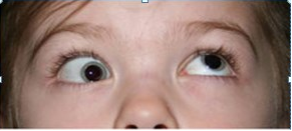Download and print as a PDF (182kB pdf)
On this page
This leaflet is intended to answer some of the questions of patients or carers of patients, diagnosed with Brown’s syndrome under the care of University Hospitals Sussex NHS Foundation Trust.
What is Brown’s Syndrome?
Also known as superior oblique tendon sheath syndrome. It is a condition where there is an inability to move the affected eye(s) into an upward and inward position. It is usually present from birth but can sometimes be acquired in adult life.

Who does it affect?
The condition usually affects only one eye but around 10% of cases will affect both eyes.
Brown’s Syndrome which is present from birth is usually caused by a tight muscle tendon / abnormality which does not allow the muscle to stretch fully.
People who acquire Brown’s syndrome later in life usually do so as a result of trauma, surgery or other inflammatory conditions such as Rheumatoid Arthritis.
What problems occur with Brown’s Syndrome?
Most people with Brown’s syndrome have no problems as the eyes are usually ‘straight’ and work together well when looking straight ahead. Some patients may experience pain, discomfort or a ‘clicking sensation’ on attempting to move the affected eye into the ‘up’ and ‘in’ (towards the nose) position. They may also notice some double vision in this position of gaze.
Sometimes patients use a “head posture” to place the affected eye away from the position where the movement is restricted to reduce symptoms. The most common head posture is to raise their chin slightly and so use their eyes in a slightly downward position. A head posture should not be discouraged as this is the most comfortable way for the child to use their eyes together and therefore can allow better visual development.
Do people with Brown’s Syndrome need glasses?
There is no evidence to suggest that people with Brown’s syndrome are any more likely to need glasses than the rest of the population. We may, however, suggest your child has a glasses test routinely.
Why do we need to keep seeing the Orthoptist?
In children it is important to see the Orthoptist fairly regularly to ensure the vision develops normally and equally and that the development of 3D vision is not impaired. The Orthoptist will guide you as to how often you will need to attend.
What treatment is available?
Most people with Brown’s syndrome don’t require any treatment. Children will be monitored by an Orthoptist to ensure amblyopia (decreased vision) doesn’t develop. If amblyopia does develop, occlusion therapy (patching) will be started to treat this.
Prisms can be used to alleviate any double vision in the straight ahead position in some cases. Surgery is usually avoided in Brown’s syndrome as the results are unpredictable and disappointing.
Many children with Brown’s syndrome show signs of improvement in their eye movements as they grow older. If the condition persists it rarely causes problems in adult life as we tend to spend very little of our time looking upwards and this is where problems are most likely to occur.
Contact Details
St Richard’s Hospital
St Richard’s Hospital
Spitalfield Lane
Chichester
West Sussex
PO19 6SE
Orthoptist
01243 831499
Southlands Hospital
Southlands Hospital
Upper Shoreham Road
Shoreham-by-Sea
West Sussex
BN43 6TQ
Orthoptist
01273 446077
The information here is for guidance purposes only and is in no way intended to replace professional clinical advice by a qualified practitioner.